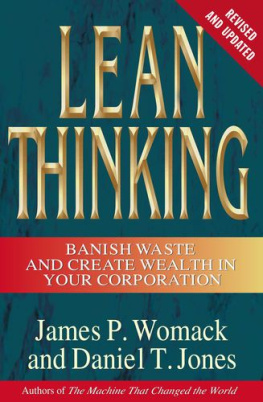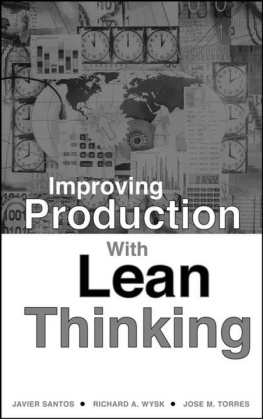Toyota Production System
Toyota Production System
Beyond Large-Scale Production
Taiichi Ohno

Foreword by Norman Bodek







Table of Contents
..... ix
.... xiii
.... xvii
.... xix
..... 1
The Oil Crisis Opened Our Eyes
Slow Growth Is Scary
"Catch Up with America"
Just-In-Time
Using a Common-Sense Idea
Give the Machine Intelligence
The Power of Individual Skill and Teamwork
Cost Reduction Is the Goal
The Illusion ofJapanese Industry
Establishing a Production Flow
Production Leveling
In the Beginning, There Was Need
A Revolution in Consciousness Is Indispensable
.. 17
Repeating Why Five Times
Complete Analysis of Waste
My Plant-First Principle
Writing the Standard Work Sheet Yourself
Teamwork Is Everything
The Skill of Passing the Baton
An Idea from the U.S. Supermarket
What Is Kanban?
Incorrect Use Causes Problems
The Talent and Courage to Rethink What We Call Common Sense
Establishing the Flow Is the Basic Condition
Use Your Authority to Encourage Them
Mountains Should Be Low and Valleys Should Be Shallow
Challenge to Production Leveling
Production Leveling and Market Diversification
Kanban Accelerates Improvements
Carrying Carts as Kanban
The Elastic Nature of Kanban
An Autonomic Nervous System in the Business Organization
Provide Necessary Information When Needed
The Toyota-Style Information System
Fine Adjustment
Coping with Changes
What Is True Economy?
Re-Examining the Wrongs of Waste
Generate Excess Capacity
The Significance of Understanding
Utilizing the Full Work System
Do Not Make a False Show
Required Numbers Are All-Important
The Tortoise and the Hare
Take Good Care of Old Equipment
Look Straight at the Reality
0.1 Worker Is Still One Worker
Management by Ninjutsu
In an Art Form, Action Is Required
Advocating Profit-Making Industrial Engineering
Surviving the Slow-Growth Economy
. 75
A Global World Around Us
Two Extraordinary Characters
Learning from the Unyielding Spirit
Toyotaism with a Scientific and Rational Nature
Provide Good Equipment Even If the Factory Is Simple
Pursuit of a Japanese-Style Production Technique
Making Products That Have Value
A Chessplayer's View
In Search of Something Japanese
Witnessing a Dialectic Evolution
.. 93
The Ford System and the Toyota System
Small Lot Sizes and Quick Setup
The Foresight of Henry Ford
Standards Are Something to Set Up Yourself
Prevention Is Better than Healing
Is There a Ford after Ford?
Inverse Conception and Business Spirit
Getting Away from Quantity and Speed
... 111
The System Raised in the High-Growth Period
Raising Productivity During Low Growth
Learning from the Flexibility of Ancient People
.. 119
.... 121
...... 131
...... 135
....... 137
Publisher's Foreword
JUST AS WE have been recognizing the greatness of Mr. Shigeo Shingo, we also recognize the genius of Mr. Taiichi Ohno. It was Mr. Ohno who should be credited with the creation of the Toyota just-in-time production system.
I met Mr. Ohno in Japan at Toyoda Gosei where he became chairman after retiring from Toyota Motors. Toyoda Gosei is a Toyota subcontractor manufacturing steering wheels, automobile parts like rubber hoses and plastic dashboards, and other materials.
At our last meeting I asked him where Toyota was today in the improvement process. By now, the company must have reduced all work-in-process inventory - lowering the water level in the river to expose all the rocks, enabling them to chip away at all the problems.
"What is Toyota doing now?" I asked.
His answer was very simple.
"All we are doing is looking at the time line," he said, "from the moment the customer gives us an order to the point when we collect the cash. And we are reducing that time line by removing the non-value-added wastes."
Simple but brilliant. It gives a very clear focus to continuous improvement. Where we in the West would look immediately for some magic automatic miracle like computer integrated manufacturing (CIM), robotics, or advanced manufacturing techniques, the Japanese are simply reducing wastes. Of course, some wastes can be removed by acquiring new equipment but that should be done last - not first.
There is nothing very complex in the magic of Mr. Ohno's teachings. In fact, it is often confusing listening to him because he talks so simply, often just saying to look for and eliminate waste. We cannot believe that it is that simple - but it is true. Just reduce the time line by removing any wastes.
Mr. Ohno's simple tale told in the book is brilliant and should be read by managers everywhere. It is not just a tale of manufacturing, it is a tale of how to run a business successfully. Mr. Ohno went back and reviewed how Henry Ford ran his business. Henry Ford was able to mine iron ore on a Monday and, using that very same iron ore, produce a car coming off the assembly-line-on Thursday afternoon.
Henry Ford also focused on the total elimination of nonvalued-added wastes. Mr. Ohno just simply updated Henry Ford. He reduced changeover times with the help of Mr. Shingo from days and hours to minutes and seconds. He eliminated job classifications to give workers flexibility.





















